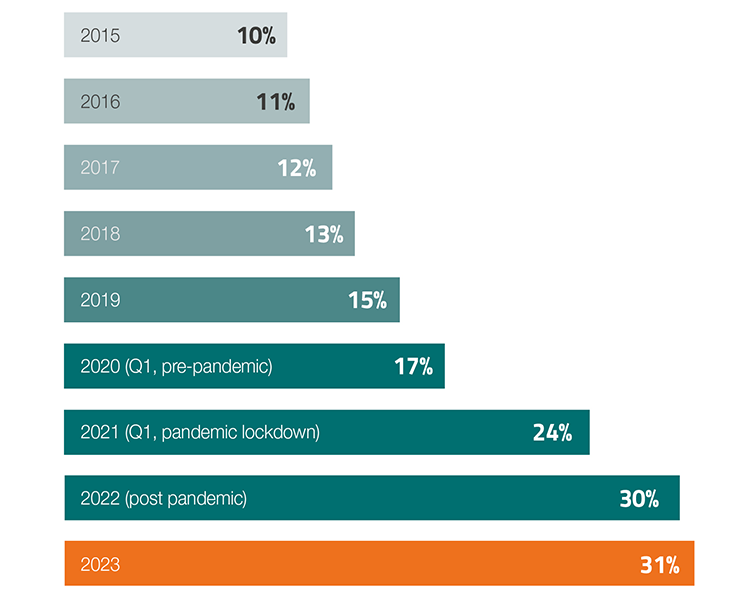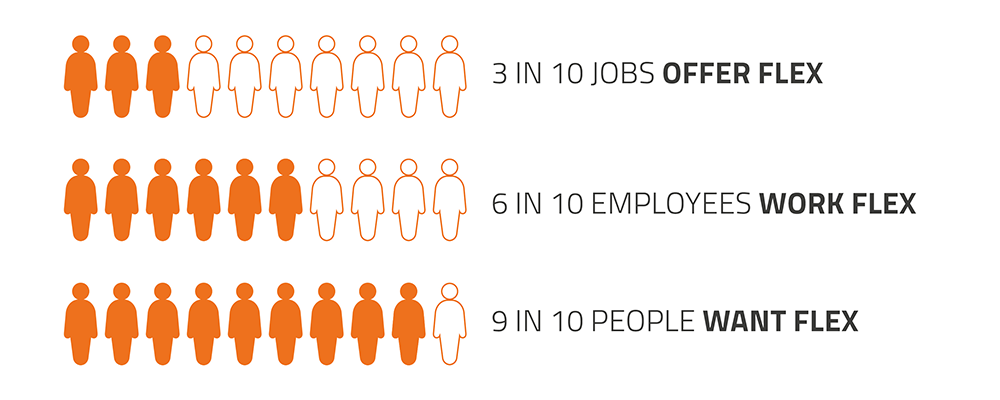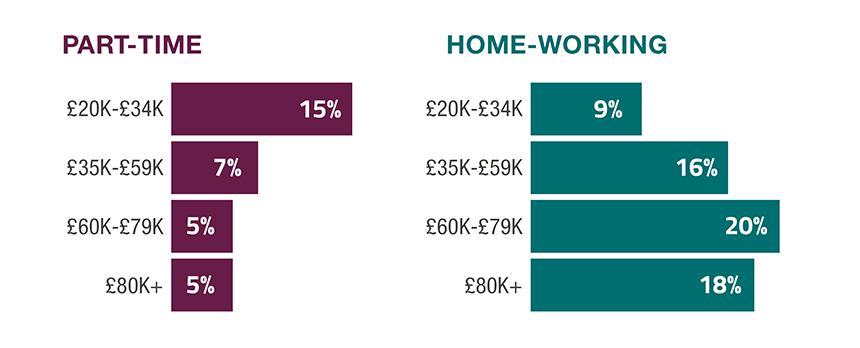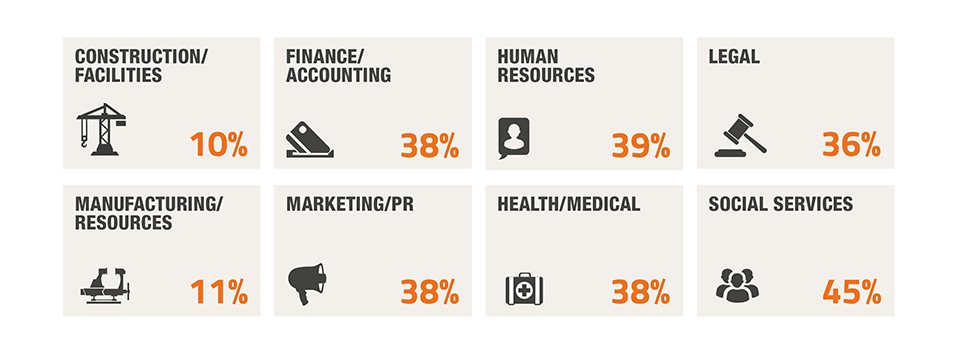

Our annual index tracks progress in the flexible jobs market.
This year, we report that progress is stalling. Is this the end of the gains made during the pandemic years?
Our 9th annual Flexible Jobs Index© reports negligible change on the previous year’s level of job adverts offering flexible working. Only 31% do so, signifying an end to the progress that was made during and since the pandemic, when hybrid working became the norm for many UK jobs.
The stagnation is surprising in the light of the Employment Relations (Flexible Working) Act 2023, with its accompanying regulation giving people the right to request flexible working from day one in a new job. It suggests that many employers remain resistant to flexibility for new recruits, and are not preparing for the change that is coming when the new law is implemented next year.
To be fair to employers, complex workplace transformation takes time. And the pressure to adapt to flex coincides with huge challenges in terms of pay rises to cover the increased cost of living, whilst grappling with an economic downturn. However, it has never been more important to look beyond the barriers and consider the evidence that flexible working is a powerful talent attraction tool. Candidates increasingly want and expect to be able to work flexibly, and with new legislation on the way that is not about to change.

The proportion of job adverts which offer flexible working appears to be stalling. The 2023 rate of 31% represents barely any increase on 30% in 2022, and follows three years of a marked upward trend during and since the pandemic, as many organisations embraced hybrid-working.

The supply of flexible vacancies lags far behind demand. 6 in 10 employees can access the benefits of flexibility in their current job, and many more people want to work flexibly. Yet only 3 in 10 jobs are advertised with flexible working – or, to look at it another way, people who need flexibility are unable to apply for 7 in 10 jobs.

The higher the salary, the lower the availability of part-time jobs. Conversely, home-working (including hybrid working) is least available in lower paid jobs and peaks for jobs paid £60k-£79k.
These imbalances create unfairness in the workplace. The lack of part-time jobs at higher salaries traps many people in their low-paid part-time roles. It also creates barriers for those who take a temporary break from work and need a part-time role to re-enter the workforce. Meanwhile, hybrid arrangements, which make up the majority of home-working jobs, are primarily associated with higher-paid office roles and are inaccessible to many.
Greater parity can be achieved, if employers look more closely at what flexibility is possible in a role and design it into jobs.

Access to flexible working at the point of hire varies widely depending on the type of role. Those that are largely based around shifts offer flex the most – for example social services (45% of job adverts) and medical/health (38%). Above average access to flex is also offered in a number of office-based role categories, because of increased home-working – for example, HR (39%), marketing (38%), and finance (38%).
But some role categories have stubbornly low rates of flex, such as manufacturing (11%), and construction (10%). This may be gender based – they are male dominated roles where historically low requests for flexibility may have shaped cultural resistance to it.
CIPD research published in May 2023 found that 49% of employers were not even aware of the 2023 legislation on flexible working, and the regulation around the day-one right to request it. So first, employers need to read up on the new legislation and think through how they will incorporate it into their processes.
The best way to gain knowledge and confidence on how to make flexibility work in your organisation is to find successful examples in your sector. Guidance on flexible job design will be helpful, as will advice on how to support line managers to implement flex.
Look particularly at how to make a success of hybrid working, which is currently the subject of much doubt amongst employers. Before you row back on hybrid, or decide not to trial it, invest time in understanding models that are successful.
And finally, it’s a mistake to assume that candidates will know they can ask for flexible working at interview. People who need flex want to know it’s on offer before they waste time on an application. This is especially true if they have been out of the labour market for a while, as they may lack the confidence to ask. So be sure to state clearly in your job adverts which types of flexibility are possible for the role.
Watch the Timewise Flexible Jobs Index© 2023 webinar below:
Flexible hiring – advertising job vacancies as flexible from day one – is a key building block for fair access to work. It is a lifeline for people who need to work flexibly; a tool for employers to attract more talent; and at a societal level, it can help tackle inequality.
Yet the latest Scottish Flexible Jobs Index finds that only 28% of advertised vacancies offer flexible working, barely any higher than the previous year (27%). This rate lags far behind both demand for flexibility and workplace practice – 8 in 10 Scottish people want to work flexibly, with 6 in 10 already doing so.
There are also several underlying concerns. Home-working (including hybrid) is the only form of flexibility that is increasing, while part-time arrangements (highly sought by people with caring commitments) show no growth at all. And potential inequalities between workers are exacerbated by wide discrepancies in access to flex at different salary levels, by occupation and by region.
Employers need to change their approach as a matter of urgency, especially in light of forthcoming legislation on the ‘day one right to request flexible working’. Our report contains recommendations for employers and policy makers on how best to adapt.
In 2020, we were commissioned by the Scottish Government to help improve access to fair flexible working for parents and carers, as part of their Tackling Child Poverty Delivery Plan. Having carried out a feasibility study, we concluded that we need to take a systemic approach, equipping intermediaries who were already working with job seekers and employers, so they were able to advise on flexible working.
The result was Fair Flexible Work for Scotland, a two-year programme through which we created a network of Change Agents from 70 intermediary organisations. We trained them up to offer the right support, as well as connecting them to a range of wider experts on flexible working, including the Scotland-based Flexibility Works.
This report sets out how we carried out this work, and shares the positive outcomes from the programme. It’s fair to say that it was a resounding success; highlights include 80% of participants saying they have a better understanding of how to influence employers to enable a fairer, more successful approach to hybrid working, and 76% strongly agreeing that “I am motivated to take action to ensure fairer access to flexible work by more people.” We will continue to monitor the impact of the support that the Change Agents are providing, and are currently exploring the potential of replicating this model elsewhere in the UK.
Published September 2022
In July 2021, we published the report into our Construction Pioneers Pilot, and it caused quite a stir. The 18-month programme was carried out in partnership with Build UK and four pioneer firms – BAM Construct, BAM Nuttall, Skanska UK and Wilmot Dixon – and set out to challenge the concept that frontline site-based roles were incompatible with flexible working. The outcomes were clear; and overnight, some long-held assumptions were overturned.
The pilot demonstrated that flexible working CAN be implemented on construction sites, without negatively affecting budgets or delivery. It highlighted the positive impact of flexible working on workers’ sense of well-being and work-life balance. It also set out the benefits of taking a team-based approach to working patterns, and demonstrated that a culture which accepts, and champions, flexible workers, is better for everyone involved.
But for us, and for our pilot colleagues, that wasn’t the end of the story. Flexible working is a long-term change; it takes time to embed it within an organisation, and progress needs to be tracked to get a clear picture of what works.
So we agreed to come back after a year and review the situation. Were the positive outcomes sustainable, and has anything else changed for the better? What still needs to be tackled? And what can the rest of the industry learn from all this? Our One Year On Review holds the answers.
To start with, the continuing positive impact on employees is clear. All four firms agreed that even small changes to ways of working were helping their staff better manage the challenges of day-to-day life, taking away potential problems that could increase stress.
The employees we interviewed also felt that they were more trusted and better understood, and that it was easier to discuss flexible working and make changes in a collaborative way with their managers. The managers themselves felt they were more open to trying out new ways of working, recognising that if it benefits their teams, it benefits the business too. That’s quite a culture shift.
And critically there was new evidence, from interviews and HR feedback, of a reduction in sickness absence. This is particularly notable in comparison to the rest of the construction industry, in which sickness absence is on the rise. All four participating firms believe that flexible working has contributed to this reduction, and given that one of our initial aims was to tackle the industry’s poor mental health and well-being record, it’s a welcome development.
Additionally, the firms have reported increased productivity levels, which they feel is the result of having a happier workforce who are better able to manage their commitments outside of work. And all this is still being delivered without any negative impact on either budget or delivery.
A further positive outcome is that our pioneer firms are now so confident about the value of flexible working that they have felt able to offer it from the point of hire. This is rare within construction, and likely to seriously improve the industry’s gender pay gap.
The review also noted some areas where there is more work to be done. There’s still a need for more consistency in management practice across the firms, and more time needs to be spent exploring other forms of flexible working. Part-time work, in particular, is still rare to the point of invisibility, particularly for on-site roles.
It also highlighted the as-yet-missed opportunity of influencing other parts of the supply chain; these new attitudes towards flexible working need to ripple downwards to sub-contracted workers, and upwards to clients too.
Overall, the evidence clearly suggests that our pioneers are reaping the rewards of their flexible working trial. They are also benefitting from this review, which has given them a forum to reflect on what’s working, within and across the four firms, and refine their plans accordingly.
What’s more, this model offers real benefits for the whole sector. Why? Because our initial pilot, and this one year on review, provide a clear roadmap for change. They set out what needs to be done, offer proof of concept for flexible working, and show what’s up for grabs for others who are willing to trial it for themselves.
It’s already gathering momentum; following our initial report a year ago, we’ve been engaged by a number of other firms who are keen to move forwards with flexible working, including Sir Robert McAlpine, Kier and Balfour Beatty. It’s our expectation that the further proof provided by this review will see even more firms taking action.
And why wouldn’t they? The evidence from this programme is pretty conclusive; it’s also backed up by our own cross-sector research, which has indicated that a flexible working trial which reduces sickness absence by one day per person per year generates a positive ROI.
In the words of Suzannah Nichol MBE, CEO of Build UK, “With such positive results, particularly around diversity and well-being, Build UK will continue to champion flexible working and I would encourage other industry organisations to do so too. If you aren’t already having the flexible working conversation within your business, it is definitely one worth starting – I promise you won’t regret it.”
Published July 2022
In the summer of 2021, we published the report on our Construction Pioneers Programme; and people across the industry sat up and took notice. The programme demonstrated beyond any doubt that it IS possible to introduce flexible working for on-site roles, and that the benefits of doing so are clear.
One year on, we have gone back to our Construction Pioneers to review their progress; and the good news is, flexible working is continuing to be a success story for all four firms. They have rolled out and built further on the learnings from the programme, with no detrimental effect on budgets or timelines and with plenty of positive impact on staff well-being and performance.
Additionally, our Pioneers believe that that flexible working has been a key contributor to a huge reduction in sickness absence – by over one third in two of the firms. They are also reporting increased productivity levels through the use of hybrid working, which they feel is the result of having a happier workforce better able to manage their commitments outside of work.
This review explores our Pioneers’ progress against the recommendations from our 2021 report. It highlights the impact of the changes they have made, and shares insights from leaders about what works. And it also sets out what needs to happen to cascade these learnings across the industry as a whole.
Published July 2022
In frontline sectors, which often run on tight margins and with an acceptance that staff churn is high, it’s particularly difficult to make a business case for investment in flexible working. But frontline workers have borne the brunt of the pandemic, whilst seeing other workers reap the benefits of increased homeworking and flexible hours. In the face of acute skills shortages, employers need to level up by seeking flexible solutions for frontline workers, or risk losing even more of them.
Following on from successful pilot programmes in five frontline sectors (retail, construction, social care, teaching and the NHS), Timewise commissioned the Institute for Employment Studies to undertake a break-even analysis of investing in flexible working. IES calculated how quickly the benefits of improved retention and reduced sickness absence could offset the costs of a typical programme.
The findings make a strong case: within just a few years, savings begin to outweigh the costs of implementing flexible working, and begin to deliver financial returns.
We hope this powerful analysis will help fill the evidence gap on flexible working ROI, and provide the impetus for employers and policymakers to prioritise investment in changes to working patterns, for the benefit of business, the individuals they employ, and society as a whole.
Published April 2022
The Greater Manchester Good Employment Charter sets a high standard for jobs in the region, promoting practices that support diversity and inclusion, and encouraging fair pay. Flexible working is a core part of the charter, and this report by Timewise looks at how well the region is doing when it comes to openly offering flexibility at the point of hire.
The answer is: very slightly better than the national average (at 27% versus 26%), but with some interesting granular differences. For example, in Greater Manchester, flexibility is most available in jobs paying over £60k. This is in sharp contrast to the UK as a whole, where flexibility (mainly in the form of part-time arrangements) has always been most available in low-paid jobs.
And home-working, which is now commonplace for office-based staff, is being offered in only 11% of the region’s job adverts.
There is a clear need for employers in Greater Manchester to do more, and faster. Flexible hiring can reach a wider talent pool – essential in today’s challenging jobs market, where applications are in short supply.
More importantly, flexible working is essential to creating fairer, more inclusive workplaces. It should need no explanation that inclusivity must start at the point of hire, and not be restricted to existing staff. Nor must it be restricted to certain types of jobs or salary levels.
We hope that the Flexible Jobs Index for Greater Manchester will inspire the region’s key anchor institutions to champion flexible hiring as part of their wider inclusive growth strategies. And we hope it will galvanise Greater Manchester employers to consider flexible working as a matter of routine when they advertise jobs – alongside salary, pension and other benefits.
The event was hosted by our Development Director, Emma Stewart, and featured a panel of business leaders who provided their own insights and analysis about what they’re seeing on the ground, as well as their suggestions for what needs to be done to shift the dial. We’ve included a recording of the event below.
Among the key themes which emerged were:
Our thanks got to our panel for sharing their insights and experience: Neil Carberry, CEO, The Recruitment and Employment Confederation; Jonny Briggs, Head of Talent Acquisition and D&I, Aviva; Farrah Ekeroth, Head of Employer Brand, EY and Jane Galloway, Head of Flexible Working, NHS England.
Since March 2020, a workplace revolution has taken place. Pandemic-enforced lockdowns have triggered a huge uplift in remote working, which appears to be here for the long term; at the time of writing, large numbers of employees who previously worked in offices remain home-based, and many companies are offering hybrid working arrangements for their teams.
But while much has been written about the move towards location-based flexible working – that is, people working from home or in other off-site locations – there has been little, if any, attention given to time-based flexible working, particularly part-time. Put simply, the voices of people who cannot work full-time, and their experiences during and after the pandemic, are not being heard.
This report sets out to remedy this omission; to listen to the experiences of part-time workers and job seekers, and understand how the pandemic has impacted them. It builds on the quantitive data from our first Fair Flexible Futures report, providing real-life insights that will help employers, policymakers and labour market intermediaries drive more inclusive policy and practice.
Our working practices are changing. From the homeworking revolution to the increase in hybrid working, the debate on productivity and flexibility is likely to rage on for some time. These changes have also exposed and amplified existing inequalities, especially for part-time employees, who often work on the frontline in low-paid jobs.
Early in the pandemic, it immediately became clear that these roles were facing the brunt of job losses and changes in working hours. Furlough has been effective in keeping millions of employees in work, but it is masking significant challenges, especially for part-timers. And as we move towards economic recovery, there is a risk that the gap between the flex haves and have-nots, which existed before Covid-19, will widen significantly, leaving many frontline workers behind.
It is for this reason that we have launched Fair Flexible Futures, a campaign for change with the aim of making good jobs flexible and flexible jobs good. In this, the first in a series of Fair Flexible Futures reports, we present new analysis on how part-time employees are faring, and explore what more needs to be done to support them.